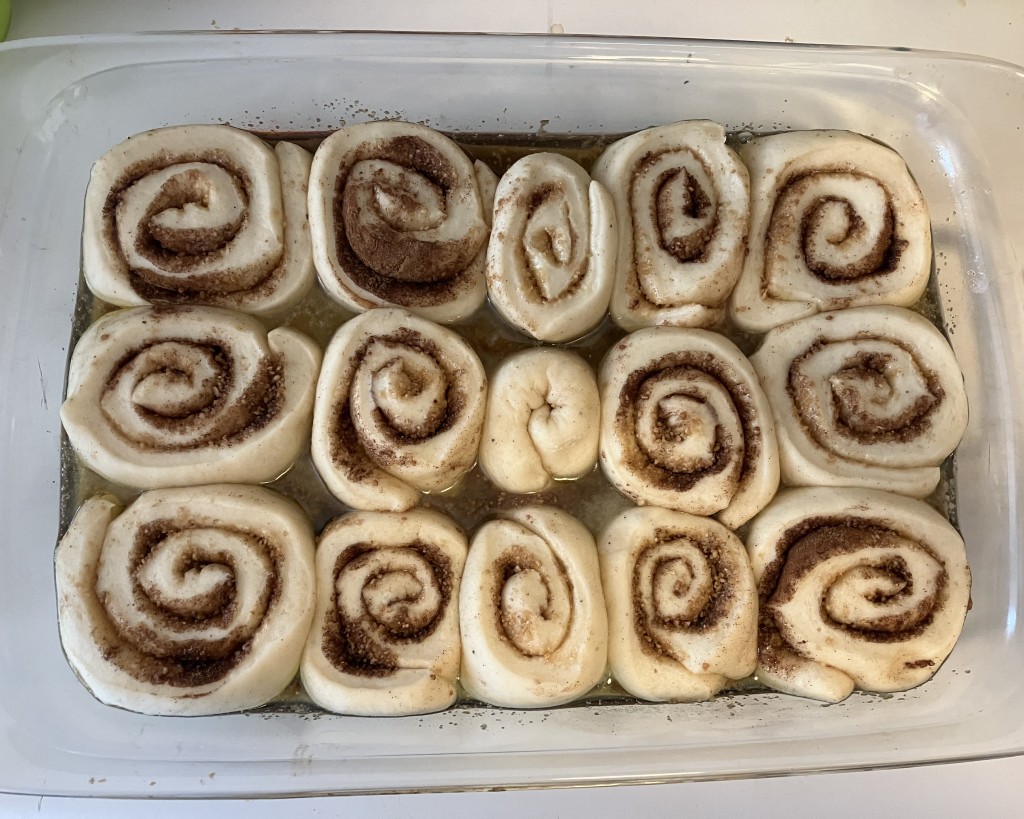These buns are named for their spiral shape like a snail’s shell – the word “Schnecken” means “snails” in German.
This recipe, from The Settlement Cook Book, presents several different options for the dough, toppings, and fillings of the buns. I opted to use the recipe for “Kuchen Dough No. 1,” since I had already used the same dough for a Spice Roll last month. This time I used bread flour instead of all-purpose, which I think makes kneading a little easier and has a nicer texture when baked (although all-purpose will work too). I used maple sugar for the filling and went with the option to top the buns with caramel glaze, a method my family uses every year to make sticky buns on Christmas Eve. We traditionally use a recipe adapted from a Betty Crocker cook book for our buns, but I realized while making this that the proportions and method of our recipe are nearly identical to this one…making me wonder if the Betty Crocker recipe was originally based on this recipe from The Settlement Cook Book. Either way, both the modern sticky buns my family makes and these Schnecken from 1901 are delicious.


Dough:
- 1 cup scalded milk, divided
- 1/4 cup butter, softened
- 1/4 cup sugar plus 1 tsp, divided
- 1/2 tsp salt
- 1/4 tsp nutmeg
- 2 1/4 to 3 cups bread flour
- 1 egg yolk
- 2 1/4 tsp active dry yeast
- To make the dough: put the softened butter, 1/4 cup sugar, nutmeg, and salt in a large bowl.
- Scald the 1 cup milk in a saucepan. Pour 1/2 cup into the bowl with the butter and sugar and the remaining 1/2 cup into a measuring cup or small bowl.
- When the milk has cooled slightly, add the yeast and 1 tsp sugar to the measuring cup with the 1/2 cup of milk. Stir to combine and set aside for a few minutes until the yeast is foamy.
- Add the beaten egg yolk to the butter mixture. Stir in the yeast mixture.
- Gradually add the flour until the mixture forms a dough stiff enough to knead; you may not need all the flour.
- Turn out the dough on a lightly floured surface and knead until smooth, 10-15 minutes.
- Place the ball of dough in a lightly greased or buttered bowl and let rise in a warm place until doubled, about 1 hour.
Filling:
- maple sugar
- cinnamon
- about 1 tbsp melted butter
Glaze:
- about 2/3 cup melted butter
- about 1 cup brown sugar
- When the dough is nearly done rising, prepare the glaze by mixing the melted butter and brown sugar together in the bottom of a 9×13 baking pan.
- Roll out the dough to a rectangle about 14×8 inches. Brush the dough with melted butter and sprinkle with maple sugar and cinnamon.
- Roll up the rectangle from the long side to form a long roll. Cut the roll into 15 roughly equal pieces. Arrange the rolls cut-side up on top of the glaze in the pan. The pieces cut from the ends of the roll will usually be the smallest; put those in the middle of the pan with the larger pieces around the outside.
- Let rise again, about 15-20 minutes.
- Bake at 375 degrees for about 20 minutes, until the rolls are starting to look golden-brown on top.
- Remove from the oven and carefully flip the pan over onto a rimmed baking sheet so that the caramel glaze drips over the rolls.



Tasting notes:
I love any baked goods remotely resembling cinnamon rolls, and these buns are no exception. Both the dough and the glaze came out perfectly. I did like the addition of maple sugar in the filling, but if you don’t have it, brown sugar would absolutely work instead. You could also play with the flavors and use spices other than nutmeg and cinnamon, or add raisins in the filling like my family usually does. This recipe is infinitely adaptable, and is definitely a keeper even after over 100 years.

References:
Kander, L.B. (1901). The Settlement cook book. Milwaukee, Wisconsin: J.H. Yewdale & Sons Co. https://d.lib.msu.edu/fa/66#page/348/mode/2up


Looks so much like my mother’s! Nothing makes the house smell more wonderful when baking.
LikeLike